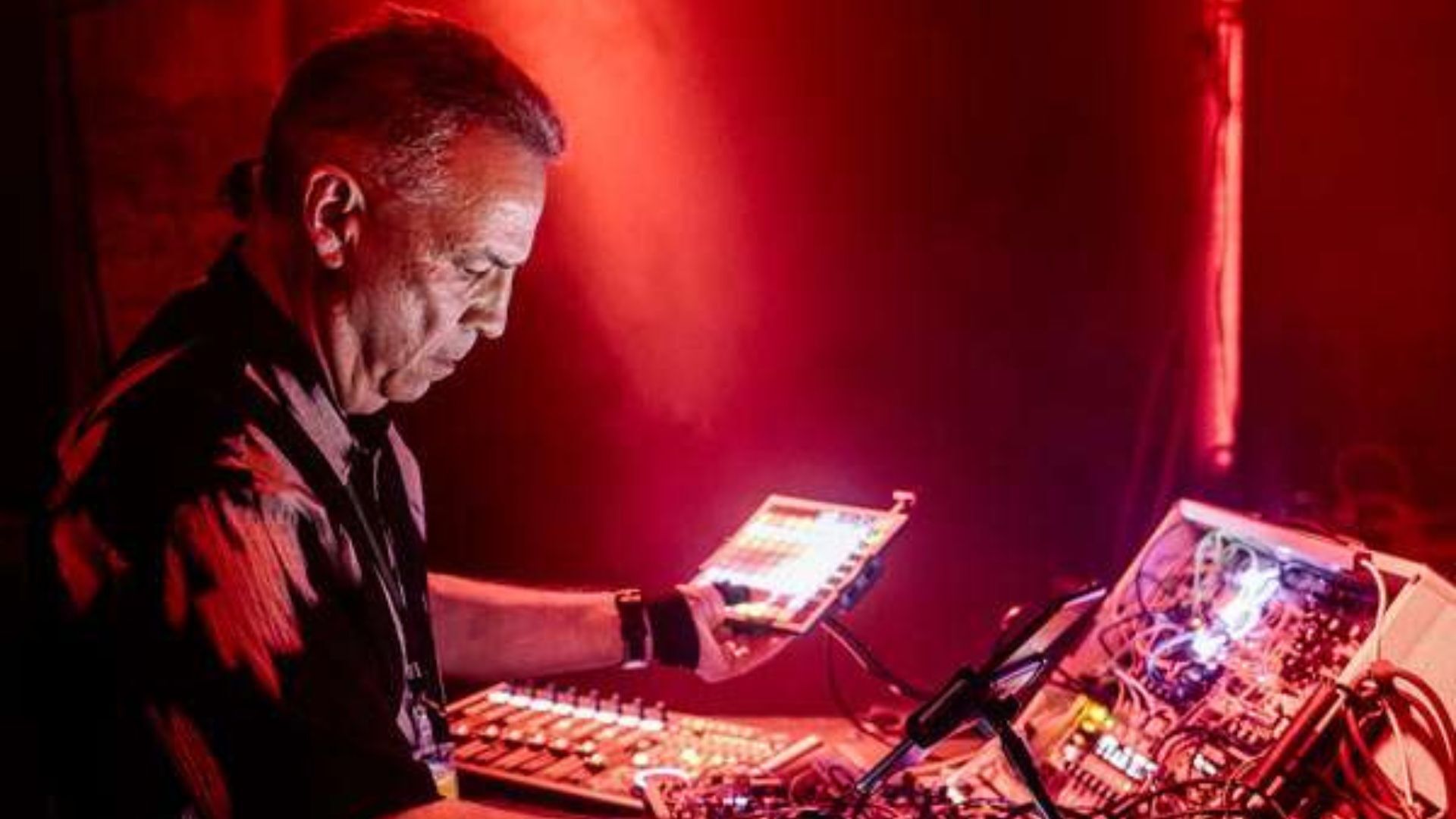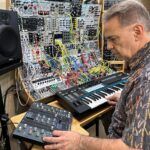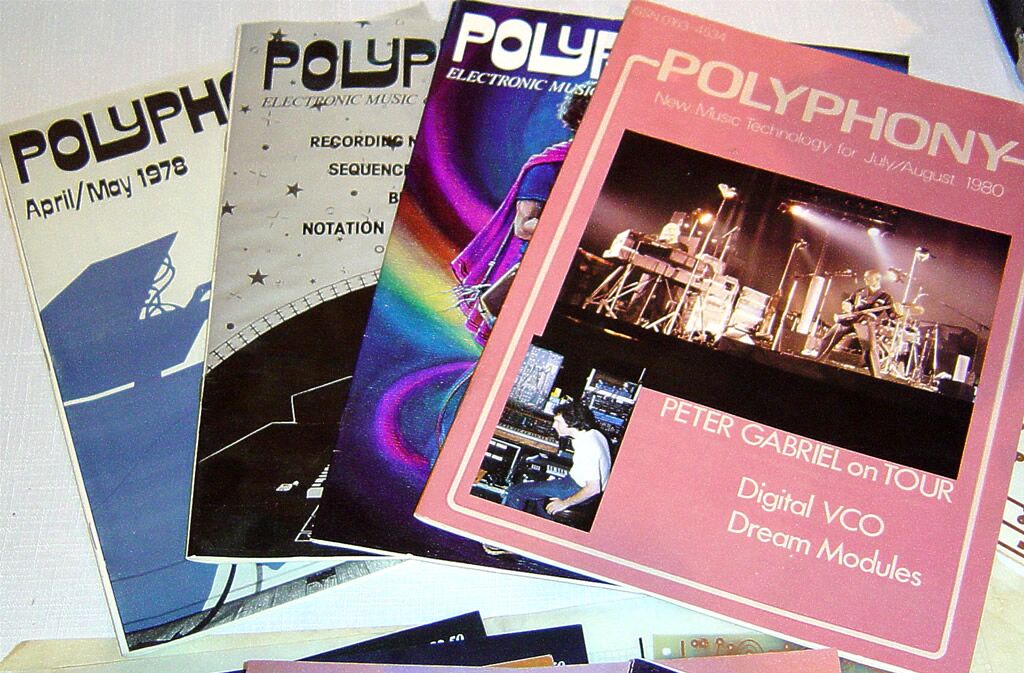Chris Meyer-New Vectors In Sound

Chris Meyer -2025 MIDI Association Lifetime Achievement Award Recipient
At the 2025 NAMM show, Chris Meyer will be receiving a MIDI Association Lifetime Achievement Award for his work with Sequential Circuits, Roland and Oberheim and as the very first chair of the MIDI Association’s Technical Standards Board. This article documents his many contributions to the world of MIDI and synthesizers.
Early Years
Chris Meyer has always had a passion for creating sounds. It started when he was quite young. Growing up in Hamilton, Ohio, he was fascinated by electronics and started listening to electronic music when he was only 10 years old.
At 16, he decided he wanted to learn more about music and bought an used Wurlitzer 200a. He was listening to Emerson, Lake and Palmer,Tangerine Dream, Klaus Schulze, Michael Hoenig, Wendy Carlos, and Larry Fast and studied piano, bass, and modular synthesizers. He soon sold the Wurlitzer to buy a PAiA modular synthesizer.

Chris Meyer
Chris wanted to pursue a career either as a musician or a recording engineer, but was strongly discouraged by his family and friends, warning he would be just another starving musician or sweeping the floors at some studio. Having an aptitude for technical matters, he decided to instead pursue an engineering degree from Rose Hulman Institute of Technology to help fund his own musical endeavors
Knowing Chris was disgruntled with his first engineering job out of college, a friend spotted an ad in the San Jose Mercury newspaper that Sequential Circuits was looking to hire someone familiar with MIDI. The position had already been open six months with no one suitable stepping forward to take it. Having read a total of one article on the subject (in Polyphony magazine by Craig Anderton), he applied for the job, was flown out to California for an interview, and was hired.

So Chris packed up his belongs and moved to the West Coast. It was actually fairly typical at the time that the people who were most involved with MIDI were in the service departments of their companies. MIDI was brand new, there were some inconsistencies in the way it had been implemented by different companies and there were both a lot of companies interested in the spec and a lot of users frustrated with the first implementations. For example, Anne Graham was in Oberheim’s service department and Jim Mothersbaugh (brother of Mark Mothersbaugh from Devo and also seen in the famous picture from the 1983 NAMM show standing next to Dave Smith) was in Roland’s service department.
But Chris was hired into the service department to fix bugs and improve the implementation of MIDI in their current products that implemented it, and into Sequential in general to represent them in the MIDI Manufacturers Association
Chris joined Sequential right at the time because Keyboard Magazine had just published its “Turmoil In MIDI Land” article.
But Chris instead of looking at this article as a negative, he considered it just a technical challenge and set about working together with the engineers from other companies to fix the small inconsistencies.
This was also perfect timing for Chris because:
- Dave Smith was burnt out on dealing with MIDI politics and wanted someone inside of Sequential Circuits to deal with MIDI so Dave could focus on new products. It gave Chris a tremendous amount of instant credibility when he showed up representing Sequential Circuits in the industry.
- The Japanese Standards MIDI Committee was pushing for a manufacturers only organization in the US and outside of Japan to handle changes to the MIDI specification.
So within a few months of Chris joining Sequential, he would become an important figure in the formation of the MIDI Manufacturers Association.
The Sequential Circuits Prophet VS
Chris was always looking for new ways to create sound and although Dave Smith had an idea about combining digital waves together, it was Chris who actually created a demo of what would become the Prophet VS and sold the Sequential Circuits engineering team on the idea.
Rather than reproduce the story, we will provide a short quote and then a link to Chris’s own description of designing and prototyping the VS.
My proposal for the “Diamond Patch” which later became known as Vector Synthesis (Josh Jeffe, project manager on the Prophet VS, gave it that name) just happened to be both well-timed, and in alignment with Dave’s own priorities which I was not aware of at the time.
Dave was looking at Sequential licensing the Buchla 400, which used Timbre Modulation to change the waveform over time. He got a unit in house, and it fell to me to evaluate it. Based on its bugginess and its user interface and approach which I felt would overwhelm and confuse the typical Sequential customer, I ultimately recommend against it. But, one idea from it – multi-point, looping envelopes – did make its way into the Prophet VS, in streamlined form.
Email from Chris about this article for MIDI.org
It all started some time in 1985. We were still working on the Prophet 2000 sampler, and as resident “historian” (in other words, I had the biggest archive of synth magazines and manuals), another engineer asked me to explain how various instruments performed waveform crossfades.
I had finished discussing the Fairlight, and had moved on to the PPG – explaining its wavetables, and the ability for it to scan a group of waves first in one direction and then back again. While I was scrawling this back and forth motion in my notebook to demonstrate, suddenly a little twinge went off in the back of my head, and my hand drew the next line arcing down the page…and the concept of crossfading between waves in two dimensions, not just one, revealed itself.
Trying to imagine what it would sound like to wander around a space with different waves in each corner was a little beyond most people’s grasp at the time. So, I decided to patch it up at home on my rag-tag modular synthesizer.
As depicted in the article about 2023 MLTA winner Dave Smith and Sequential Circuits and also in our article about 2025 MIDI Lifetime Achievement Award recipient, John Bowen by 1987, Sequential Circuits was in financial trouble and by 1988 was owned by Yamaha.
The stress of working for a company that was on the verge of bankruptcy wore on Chris down, plus the company then known as Digidesign (now Avid) was interested in pursuing MIDI Timecode based applications – so he left Sequential before their demise and worked briefly for Digidesign, Music Maker Publications, and Tom Oberheim’s Marion Systems before becoming Chief Engineer of the newly-formed (but short-lived) Roland R&D Los Angeles. He continued to work for Roland US for several years after Roland R&Ds demise while representing Roland with the MIDI Manufacturers Association.
Chris’s Technical Contributions to MIDI
Chris contributed a tremendous amount to MIDI in two significant areas- technical and procedural.
From a technical point of view he drove some foundational specifications that solidified MIDI as an essential part of the music production environment. Of course, MIDI specs are not written by one person, it always takes a village. Chris was very directly involved in MIDI Time Code and MIDI Machine Control.
For example. MIDI Time Code had significant contributions from Gerry Lester of Adams-Smith and was actually submitted to the MMA by Anne Graham from Oberheim. Sequential Circuits did not want anyone to know that they were working on a sampler that could follow SMPTE.
Some of the specifications that were passed during Chris’s time as Technical Standard Board Chair include:
- Sample Dump Standard (1986)
- Defined a method for transferring sampled audio data between devices using MIDI.
- Enabled exchange of audio samples without proprietary formats.Standard MIDI Files
- MIDI Time Code (MTC) (1986)
- Introduced to synchronize MIDI devices with time-based equipment like audio recorders and video systems.
- It integrates MIDI with SMPTE time code for applications in music and video production.
- Standard MIDI Files (SMF) (1988)
- Provided a standardized file format for storing MIDI sequence data.
- Allowed interoperability across different sequencers and platforms.
- MIDI Machine Control (MMC) (1991)
- Introduced commands to control recording devices, such as play, stop, record, rewind, and fast-forward, over MIDI.
- Simplified integration of MIDI with recording hardware.
- MIDI Show Control (MSC) (1991)
- Developed to standardize communication between MIDI devices and stage lighting, effects, and other show control systems.
- Facilitates the synchronization of multimedia performances.
Today it’s hard to understand the profound impact that MIDI Time Code and MIDI Machine Control had on recording and movie making back in the late 1980s. It literally changed the way that movies were scored because you could now sync MIDI sequencers to SMPTE.
Chris’s Procedural Contributions to MIDI
As if his technical contributions were not enough, Chris also had a profound impact on drafting the procedures for the fledgeling MMA. He helped to craft the way that working groups were setup and the rules for contributions by members.
But perhaps his greatest contributions involved his negotiations with the Japanese MIDI Standards Committee (JMSC). The Japanese at the time were reticent to adding significant changes to the MIDI specification. Chris negotiated with the JMSC and arrived at an elegant solution. The JMSC did not have to agree with what the MMA proposed, they could just agree not to oppose it. In fact, it was agreed that if the JMSC did not respond within a specified time frame to a MIDI specification that was passed by the MMA (at the time it was 60 days), then the MMA could go ahead and publish the results. This worked particularly well in a a cultural context because it allowed the JMSC to “save face”.
Crish Designs and Motion Graphics
In the 90s, Chris was starting to look for new challenge. The synth world seemed to be focused on music workstations and ROM Based sample players which Chris didn’t find that interesting. So he went in a completely different direction.
Our contacts in the video and film industry came from us being regular attendees of the Cutting Edge Salon at the American Film Institute, which was formed after Apple’s QuickTime came out (that would be 1992 forward) and some saw how desktop video was going to become an industry disruptor, like desktop publishing and home recording studios were.
My transition from music to video came because I had an interest in creating music videos, and got excited by the early desktop video software being created after the introduction of QuickTime. My wife Trish – already an expert in typography – was separately interested in animating type and other graphical objects originally for multimedia.
During this time, I was working for Roland, charged with sniffing out new trends they may be interested in pursuing. This meant I went to a lot of trade shows for the burgeoning multimedia and desktop video markets, among other things.
It was there that I saw the development version of what was then called CoSA After Effects, and realized this is what both I and Trish wanted to do with our lives. We originally thought we would start small by working on commercials for the local TV market, but instead Trish’s first job was working in a 9-screen Circlevision exhibit for the Korean Expo – and we went from there.
Email from Chris about this article for MIDI.org
Crish Design is a motion graphics studio owned by Chris & Trish Meyer, authors of “Creating Motion Graphics with After Effects” and “After Effects Apprentice”.
Our motion graphic business was based around the software program After Effects; our studio was one of its original development sites. Our insistence in understanding how After Effects worked underneath the hood led to us writing 13 books and creating nearly 50 online video courses translating these technical underpinnings into advice for the practicing motion graphics artist.
Learning Modular
After running a very successful, but stressful business delivering motion graphics for big budget movies like “The Incredible Mr Ripley” and for corporate trade shows. Chris gave long and hard thought to what made him really happy and he realized it was pretty simple. He liked making music and making sounds.
I started Learning Modular in 2015 to share my own experiences learning how to use modular synths as teen and using synths from that time onward.
I eventually grew from making sounds to making music with these instruments; around 2020 I started working on composing and performing my own long-form compositions using them, resurrecting the musical project name Alias Zone that I had used nearly 20 years prior for my debut award-winning album.
Chris is a sonic explorer who has never stopped looking for the next sound and is always searching for a new vector to explore.
The MIDI Association is proud to honor him with a 2025 MIDI Lifetime Achievement Award.

